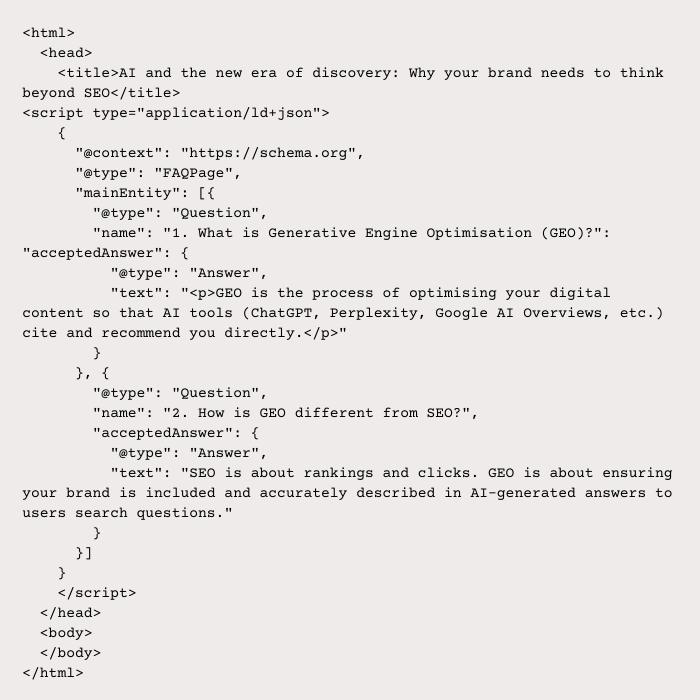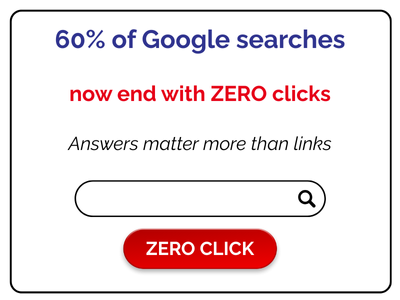AI and the new era of discovery: Why your brand needs to think beyond SEO
By Ann-Marie Reacord & Helen Hannan
Recently, one of our clients had their first ChatGPT-referred win!
The buyer had typed a question into the chatbot, something like “Who offers X in my area?”, and our client appeared at the top, described in a way that felt accurate, clear, and complimentary. A conversation with an AI tool led directly to a new lead.
Moments like this are powerful reminders: AI isn’t replacing search – it’s reshaping discovery.
And that discovery still depends on strong brand messaging, clarity of purpose, and a consistent content strategy.
The shift in search habits
In the UK, 13% of adults now say they use AI tools like ChatGPT instead of Google when searching (TechRadar). EY found that 70% of Britons have used AI in their daily life in the past six months, even though only 44% use it at work.

This tells us two things:
- Consumers are getting comfortable asking their AI assistant first.
- Traditional SEO alone can’t guarantee visibility if you’re not optimised for AI-first discovery.
Recent Ofcom data shows that Google’s UK search share has dipped from 86% to 83%. AI chat tools are growing rapidly, about 80% year-on-year, but still only account for around 3% of total web traffic. Within that 3%, platforms like ChatGPT, Perplexity, and Gemini are gaining ground.
At the same time, trust in AI-generated answers is still fragile: only 18% of UK users say they trust AI answers in Google Search. Discovery is evolving, but it’s not uniform.
From clicks to answers
Even on Google, up to 60% of searches now end with zero clicks (Search Engine Land). Featured snippets, overviews, and direct answer boxes mean the user may not visit your site at all.
That doesn’t mean you’re invisible. Users still see brand names, phrases, and summaries in those answers. The challenge is to ensure that your brand isn’t just in the search results, it’s in the answer.
Google’s AI mode: The search shift gets real
Google is already testing what it calls AI Overviews: summaries that appear at the very top of search results. Instead of scrolling through links, users see a direct, AI-generated response, often pulling from multiple sources.
Until now, this feature has been optional. But reports suggest that Google may soon make AI Mode the default, with users having to actively switch back to the “classic” link-first view. That’s a major shift: discovery would no longer begin with a list of ranked results, but with a packaged AI summary.
This reinforces the need to think beyond traditional SEO:
- Your first impression is now in the answer itself. If Google’s AI Mode defaults to summarisation, your brand needs to be included in those summaries, not buried below them.
- Authority and clarity matter more than ever. AI models are more likely to surface clear, well-structured, fact-based content.
- It reduces click-throughs even further. If AI answers the question upfront, users may never scroll to your website. Visibility comes from being cited in the overview.
In other words, the rise of Google’s AI Mode accelerates the trend we’re already seeing: brands don’t just need to be findable, they need to be quotable.
Enter GEO: Generative Engine Optimisation
This is where Generative Engine Optimisation (GEO) comes in. Think of it as the evolution of SEO:
- SEO is about ranking high in search results.
- GEO is about making sure AI tools (ChatGPT, Google AI Overviews, Perplexity, Gemini) cite and recommend you directly.
Why it matters: AI is replacing links with answers. Your visibility now depends on being the brand that AI feels confident citing.
GEO best practices
- Write in Q&A style – short, authoritative answers.
- Add AI-ready summaries to each blog or post.
- Use FAQ schema and structured data to label your content.
- Publish across high-authority platforms like (public) LinkedIn Articles, Medium, Substack, and trade press.
- Refresh content regularly: “freshness” boosts AI inclusion.
- Cite evidence and stats: AI loves facts and numbers.
- Optimise for Google AI overviews: craft content that can be quoted clearly in AI-generated summaries, focusing on concise, fact-rich explanations.

How The Listening People helps
At The Listening People, we help brands adapt to this new discovery landscape – clarifying narratives, structuring content, and building confidence that you’ll be found where your audiences are searching.
Specifically, we:
- Bring clarity and confidence to your positioning, brand narrative and value proposition
- Create strong content strategies that speak to your target audience where they are
- Pinpoint the questions your target audience asks AI tools.
- Craft concise, context-rich content designed to be quoted accurately.
- Preserve brand tone and narrative so your identity stays distinct, even when surfaced through an AI interface.
- Integrate AI-aware content planning into broader strategies – not as a bolt-on, but as part of your brand ecosystem.
Key takeaways
- Discovery is changing: AI chat tools are rising fast, but Google still dominates.
- Clicks are falling: Zero-click searches mean answers matter more than links.
- Google’s AI Mode is coming: With AI Overviews set to become the default, brands must be prepared to appear inside AI-generated summaries, not just below them.
- GEO is essential: Optimise for how AI summarises you, not just how Google ranks you.
- Clarity wins: Brands that communicate clearly, consistently, and with context will be surfaced first.
FAQs
1. What is Generative Engine Optimisation (GEO)?
GEO is the process of optimising your digital content so that AI tools (ChatGPT, Perplexity, Google AI Overviews, etc.) cite and recommend you directly.
2. How is GEO different from SEO?
SEO is about rankings and clicks. GEO is about ensuring your brand is included and accurately described in AI-generated answers to users search questions.
3. Why does GEO matter now if Google still dominates?
Habits are shifting. Early adopters are already asking AI first, and traditional clicks are falling. Getting GEO-ready now ensures you’re visible as discovery evolves.
4. What are the first steps to making my brand GEO-ready?
Start by ensuring your brand narrative is clear and consistent, and then give your content sharp summaries and Q&As that tell AI that you have the answers. Then expand onto platforms AI scrapes, and monitor how your brand appears in LLMs.
If you are interested in exploring how Generative AI can be integrated into the work of your B2B Marketing and Communications team, or if you would like to discuss tailored AI training, including our Mastering AI in Marketing course, please get in touch by emailing hello@thelisteningpeople.com.



